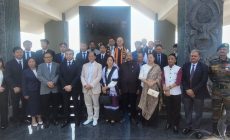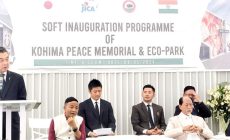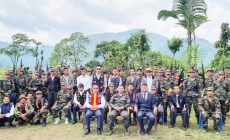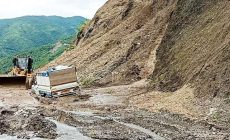Panel discussion at DGC explores various issues
Dimapur, June 29 (MExN): Can the exploration and production of oil and natural gas be used as the ‘panacea’ for combating the developmental challenges of Nagaland?
This was one of the many issues deliberated during a panel discussion on “Oil and Natural Gas Exploration and Production in Nagaland: It’s Relevance Today” held today at Dimapur Government College (DGC), Dimapur.
The DGC’s Department of Economics and Internal Quality Assessment Cell (IQAC), DGC collaborated with the Business Association of Nagas (BAN) to explore the issues.
In his keynote address, Nagaland Minister for Soil and Water Conservation, & Geology and Mining, V Kashiho Sangtam noted that oil and natural gas are viable resource for the future and needed to be explored to combat the economic challenges of the state.
However, he batted for having a clear situational and contextual picture and an early resumption of oil exploration, as per the Rapporteurs’ Report of the discussion.
Earlier, welcoming the gathering, DGC Principal Dr M Libanthung Ngullie ‘warmed up’ the proceedings by stating that those who own the land and resources still remain contested, with the Article 371A and PIL on the issue in context.
Imtikokla Ozukum, Assistant Professor, Department of Economics, DGC also gave a brief thematic exposition on the topic.
‘Misgivings played a vital role in stalling the oil exploration and its associated policies,’ maintained Mmhonlumo Kikon, MLA & Advisor, Information Technology and Communication, Science and Technology & New and Renewable Energy.
Sharing on the theme, Kikon who was one of the four panelists, however said that one needs to analyse and study the laws related to oil and natural gas exploration.
Accordingly, he batted for educated leaders as well as the need to study the Article 371A vis-à-vis Union list and modalities in the larger interest of development of economy, adding that unless such modalities are resolved, the issue of oil exploration would be stalled.
The Advisor further noted the Government of Nagaland (GoN) also needs to have a refinery to convert the crude oil to sellable product and engage a ‘high profile secured company, not some new companies without any guarantee on delivery,’ for exploration.
To this end, he noted that it is pertinent to see how the ongoing Tripartite and the Bi-partite agreements are being drafted; but noted that such initiatives are needed as a source to “stop the begging bowl.”
Senior Advocate, Guwahati High Court, Kohima Bench and President, & President, High Court Bar Association, Kohima, CT Jamir, meanwhile, noted that matter is sub-judice. People to understand the implications of law and especially why the project could not commence, he said. Earlier in 2019, Jamir was appointed by Guwahati HC to ‘help and assist’ in the hearing of the Public Interest Litigation (PIL).
Technicalities involved
Another panelist Kekhriezavi Lea informed on seismic activities carried out as a part of exploratory survey for oil and natural gas.
The Team Leader, Operational Wing, Nagaland Petroleum and Natural Gas, Department of Geology and Mining, Nagaland & OSD of the Department further said that there is potential for intensive exploration of petroleum and Natural Gas in the Naga Hills because of location of prospective areas.
However, he alluded that there is need for faster exploration as ‘resources are finite and alternative means are sought by the Government of India.
Another panelist, Meyabi Arho Niphi, Deputy General Manager (Administration – Frontier Basin) Oil India Ltd., Duliajan, Assam, among others, shared on technicalities involved in oil exploration and production.
He noted that the process can be compressed into three phases: Upstream – seismic survey to locate crude oil; midstream – bringing to surface and storage and transportation; and downstream – where midstream process becomes input.
Further clearing some misperception about drilling, the DGM further said that for first seismic survey, the standard period time frame is 8 years.
Accordingly, assuming that the PIL is cleared, he gave a rough timeline of exploration and production: 2023 – exploration phase and 2030-2035 as the window period to complete. He estimated the timeline for production phase in 2036.
If Nagaland is serious about oil exploration, it should not be looking at a time span of 5-10 years and need to understand that it is a time taking process, he added.
An interactive discussion after the presentation covered various issues such as trail to ONGC by GoN explore and extract oil in 1973 and another extraction in 1981, Champang issue, State’s energy roadmap, Article 371A and other issues.
Concluding the discussion, the moderator and BAN President Mongkum Jamir remarked that it was clear from the proceedings that there is “unanimous” decision that oil exploration and production need to be started, but in a professional manner, the Rapporteurs’ Report said.
A press release from the DGC also informed that panel deliberated that the statuses of non-renewable resources or energy are constantly evolving and there is need for looking into the feasibility of using the available resources for economic development at the right time, it said.
With the Art 371A in context, the need for taking up wide sensitisation on the use of resources and the processes involved to all stakeholders were also highlighted. “This will ensure that no stakeholder should lose out while exploring natural resources in the State, at the same time ensuring that economic development would take place,” it added.
Source: https://morungexpress.com/can-oil-and-natural-gas-combat-nagalands-economic-challenges







 The Top Viral YouTube Videos of 2017
The Top Viral YouTube Videos of 2017 The last Konyak headhunters of Nagaland
The last Konyak headhunters of Nagaland An orbiting message of peace
An orbiting message of peace What Does Your Face Say About Your Health?
What Does Your Face Say About Your Health?










Leave a Reply
Your email address will not be published. Required fields are marked (required)